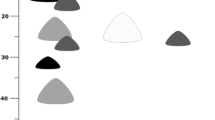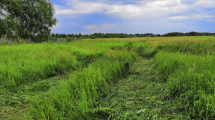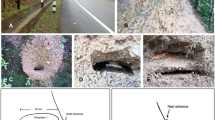Abstract
Paper wasps of the genus Polistes exhibit wide variability both of the color and size of foundresses, and the mode of colony foundation. The colony foundation and social hierarchy were studied in populations of two Palaearctic species, Polistes dominulus (Christ) and P. nimphus (Christ) (April–May 2006, the Crimean Peninsula, Ukraine), and one Neotropical species, P. lanio (F.) (October 2004–January 2005, Trinidad Island). It was shown that foundresses of various color and size morphs tended to found nests in a peculiar way: singly (haplometrosis), by groups (pleometrosis), or occupying several nests simultaneously (polycaly). The relationship between coloration, size, and mode of colony foundation was species-specific. P. dominulus foundresses with a darker clypeus and a paler mesonotum preferred to found nests alone and had a dominant position in pleometrosis. The haplometrotic P. nimphus foundresses more often displayed darker variants of the clypeus and paler variants of the mesonotum than did foundresses from pleometrotic colonies. P. lanio foundresses from pleometrotic colonies differed from those from polycalic colonies in the coloration variability of the scutum, propodeum, and the 2nd metasomal tergite. The dominant and subordinate P. nimphus and P. lanio foundresses differed in the size of head and wings. The possible significance of the subdivision of foundresses into the “generalists” and “specialists” for the variability structuring in the population is considered.
Similar content being viewed by others
References
Cant, M.A. and Field, J., “Helping Effort and Future Fitness in Cooperative Animal Societies,” Proc. R. Soc. London B 268, 1959–1964 (2001).
Dlusskii, G.M., Fedoseeva, E.B., and Tompson, L.Ch., “Variability in the Ants Solenopsis richteri and S. wagneri (Hymenoptera, Formicidae): Statistical Analysis of Morphological Data,” Uspekhi Sovrem. Biol. 118(3), 283–298 (1998).
Dropkin, J.A. and Garnboa, G.J., “Physical Comparisons of Foundresses of the Paper Wasp Polistes metricus (Hymenoptera: Vespidae),” Canad. Entomol. 113, 457–461 (1981).
Enteman, W.M., Coloration in Polistes (Carnegie Inst., Washington, 1904).
Gamboa, G.J., “Intraspecific Defense: Advantage of Social Cooperation among Paper Wasps Foundresses,” Science 199, 1463–1465 (1978).
Gamboa, G.J., “Comparative Timing of Brood Development between Multiple-and Single-Foundress Colonies of the Paper Wasp, Polistes metricus,” Ecol. Entomol. 5, 221–225 (1980).
Giannotti, E. and Machado, V.L., “The Seasonal Variation of Brood Stages Duration of Polistes lanio (Fabricius, 1775) (Hymenoptera, Vespidae),” Naturalia Sao Paulo 19, 97–102 (1994).
Giannotti, E. and Mansur, C.B., “Dispersion and Foundation of New Colonies in Polistes versicolor (Hymenoptera, Vespidae),” Ann. Soc. Entomol. Brazil 22(2), 307–316 (1993).
Gibo, D.L., “The Selective Advantage of Foundress Associations in Polistes fuscatus (Hymenoptera: Vespidae): a Field Study of the Effects of Predation on Productivity,” Canad. Entomol. 110, 519–540 (1978).
Glantz, S.A., Primer of Biostatistics, 4th Ed. (McGraw-Hill Inc., New York, 1997; Praktika, Moscow, 1999) [in Russian].
Gobbi, N. and Zucchi, R., “On the Ecology of the Polistes versicolor versicolor (Oliver) in Southern Brazil (Hymenoptera, Vespidae, Polistini): II. Colonial Productivity,” Naturalia Sao Paulo 10, 21–25 (1985).
Grechka, E.O. and Kipyatkov, V.E., “Seasonal Cycle of Development and Caste Differentiation in the Wasp Polistes gallicus L. (Hymenoptera, Vespidae): II. Dynamics of the Colony Growth and Production,” Zool. Zh. 63(1), 81–94 (1984).
Itô, Y., “Shifts of Females between Adjacent Nests of Polistes versicolor (Hymenoptera: Vespidae) in Panama,” Insectes Soc. 31(1), 103–111 (1984).
Itô, Y., Behavior and Social Evolution of Wasps: the Communal Aggregation Hypothesis (Oxford Univ. Press, Oxford, 1993).
Jeanne, R.L., “Construction and Utilization of Multiple Combs in Polistes canadensis in Relation to the Biology of a Predaceous Moth,” Behav. Ecol. Sociobiol. 4, 293–310 (1979).
Jeanne, R.L. and Morgan, R.C., “The Influence of Temperature on Nest Site Choice and Reproductive Strategy in a Temperate Zone Polistes Wasp,” Ecol. Entomol. 17, 135–141 (1992).
Khlebovich, V.V., “Levels of Homeostasis,” Priroda, No. 2, 61–65 (2007).
Knyazeva, E.N. and Kurdyumov, S.P., Laws of Evolution and Self-Assembly of Complex Systems (Nauka, Moscow, 1994) [in Russian].
Krebs, J.R. and Davies, N.B., An Introduction to Behavioral Ecology (Blackwell Sci. Publ., Oxford, 1993).
Kreslavskii, A.G., “Ecological Structure of the Population and the Organization of Variability,” Byul. MOIP 89(5), 687–696 (1984).
Naumov, N.P., “Biological Signal Fields and Their Significance for the Life of Mammals,” in Recent Advances in Theriology (Nauka, Moscow, 1977), pp. 93–110 [in Russian].
Noonan, K.M., “Individual Strategies of Inclusive-Fitness-Maximizing in Polistes fuscatus Foundress,” in Natural Selection and Social Behavior: Recent Research and New Theory, Ed. by R.D. Alexander and D.W. Tinkle (Chiron Press, New York, 1981), pp. 18–44.
Panov, E.N., Animal Behavior and Ethological Structure of the Population (Nauka, Moscow, 1983) [in Russian].
Pardi, L., “Dominance Order in Polistes Wasps,” Physiol. Zool. 21, 1–13 (1948).
Perfil’eva, K.S., “Wing and Genital Anomalies in Sexual Ant Morphs (Hymenoptera, Formicidae) with Different Mating Strategies,” Zool. Zh. 79(11), 1305–1312 (2000).
Pratte, M., “Mobilitédes fondatrices de Polistes gallicus,” in Ecologie des Insectes Sociaux, Ed. by D. Cherix (Lausanna, 1980), pp. 133–140.
Prigogine, I. and Nikolis, G., Perception of the Complex (Editorial URSS, Moscow, 2003) [in Russian].
Queller, D.C., Zacchi, F., Cervo, R., et al., “Unrelated Helpers in Social Insects,” Nature 405, 784–787 (2000).
Reeve, H.K., “Polistes,” in The Social Biology of Wasps, Ed. by K.L. Ross and R.W. Matthews (Cornell Univ. Press, New York, 1991), pp. 99–148.
Röseler, P.-F., “Endocrine Basis of Dominance and Reproduction in Polistine Paper Wasps,” in Experimental Behavioral Ecology, Ed. by B. Hölldobler and M. Lindauer (Sunderland, Sinauer, 1985), 259–270.
Röseler, P.-F., “Reproductive Competition during Colony Establishment,” in The Social Biology of Wasps, Ed. by K.L. Ross and R.W. Matthews (Cornell Univ. Press, New York, 1991), pp. 309–335.
Röseler, P.-F., Röseler, I., and Strambi, A., “The Activity of corpora allata in Dominant and Subordinated Females of the Wasp Polistes gallicus,” Insectes Soc. 27, 97–107 (1980).
Röseler, P.-F., Röseler, I., and Strambi, A., “Influence of Insect Hormones on the Establishment of Dominance Hierarchies among Foundresses of the Paper Wasp, Polistes gallicus,” Behav. Ecol. Sociobiol. 15, 133–142 (1984).
Röseler, P.-F., Röseler, I., and Strambi, A., “Role of Ovaries and Ecdysteroids in Dominance Hierarchy Establishment among Foundresses of the Primitively Social Wasp, Polistes gallicus,” Behav. Ecol. Sociobiol. 18, 9–13 (1985).
Röseler, P.-F., Röseler, I., and Strambi, A., “Studies of the Dominance Hierarchy in the Paper Wasp, Polistes gallicus (L.),” Monitore Zool. Ital. (N. S.) 20, 283–290 (1986).
Rusina, L.Yu., “Social Structure of Pleometrotic Colonies of Polistine Wasps (Hymenoptera: Vespidae) in the Southern Ukraine,” Vestnik Zool., nos. 4–5, 3–10 (1999).
Rusina, L.Yu., “Relocation of Foundresses at the Colony Formation Stage in Polistine Wasps (Hymenoptera: Vespidae),” Izv. Kharkov. Entomol. Obshch. 8(1), 14–15 (2000).
Rusina, L.Yu., “The Impact of Birds and a Grasshopper Decticus verrucivorus (Orthoptera, Tettigoniidae) on Polistes dominulus (Hymenoptera, Vespidae) and P. gallicus Paper-Wasp Populations in the Black Sea Reserve,” Vestnik Zool. 37, 96 (2003).
Rusina, L.Yu., Polistine Wasps in Natural and Anthropogenic Landscapes of the Lower Dnieper Area (Kherson Gos. Univ., 2006) [in Russian].
Rusina, L.Yu., Firman, L.A., Skorokhod, O.V., and Gilev, A.V., “Geographic and Chronographic Coloration Variability in the Populations of Polistes gallicus (Linnaeus, 1767) (Hymenoptera, Vespidae),” Kavkaz. Entomol. Byul. 1(2), 179–188 (2005).
Rusina, L.Yu., Gilev, A.V., Skorokhod, O.V., and Firman, L.A., “Seasonal Dynamics of the Phenotypic Structure of a Population of the Paper Wasp Polistes dominulus (Christ) (Hymenoptera, Vespidae),” Entomol. Obozr. 85(1), 39–48 (2006) [Entomol. Review 86 (2), 168–175 (2006)].
Rusina, L.Yu., Gilev, A.V., Skorokhod, O.V., et al., “Coloration of the Wasp Polistes dominulus in Relation with Its Spatial and Ethological Population Structure in the Lower Dnieper Area,” Uspekhi Sovrem. Biol. 127(2), 157–165 (2007).
Schmalhauzen, I.I., Pathways and Laws of Evolution (Nauka, Moscow, 1983) [in Russian].
Sergievskii, S.O., “Polymorphism as a Universal Adaptive Population Strategy,” Trudy Zool. Inst. Akad. Nauk SSSR 160, 41–58 (1987).
Setrov, M.I., Organization of Biological Systems (Nauka, Leningrad, 1971) [in Russian].
Setrov, M.I., Information Processes in Biological Systems (Nauka, Leningrad, 1975) [in Russian].
Severtsov, A.S., “Intraspecific Diversity as a Factor of Evolutionary Stability,” Zhurn. Obshch. Biol. 51(5), 579–589 (1990).
Shilov, I.A., “On the Mechanisms of Animal Population Homeostasis,” Uspekhi Sovrem. Biol. 64(2), 333–351 (1967).
Shilov, I.A., Eco-Physiological Basis of Population Relations in Animals (Moscow Gos. Univ., 1977) [in Russian].
Shilov, I.A., “Principles of Intrapopulational Organization and the Biological Significance of the Spatial and Ethological Structure,” in Population Structure in Mammals (Nauka, Moscow, 1991a), pp. 5–20 [in Russian].
Shilov, I.A., “Mechanisms of Formation and Maintenance of the Spatial and Ethological Population Structure,” in Population Structure in Mammals (Nauka, Moscow, 1991b), pp. 65–85 [in Russian].
Starr, C.K., “Nest Reutilization by Polistes metricus (Hymenoptera: Vespidae) and Possible Limitation of Multiple-Foundress Associations by Parasitoids,” J. Kansas Entomol. Soc. 49(1), 142–144 (1976).
Starr, C.K., “Nest Reutilization in North American Polistes (Hymenoptera: Vespidae): Two Possible Selective Factors,” J. Kansas Entomol. Soc. 51(3), 394–397 (1978).
Starr, C.K., “The Nest as the Locus of Social Life,” in The Social Biology of Wasps, Ed. by K.L. Ross and R.W. Matthews (Cornell Univ. Press, New York, 1991), pp. 520–539.
Strassmann, J.E., “Evolutionary Implications of Early Male and Satellite Nest Production in Polistes exclamans Colony Cycles,” Behav. Ecol. Sociobiol. 8, 55–64 (1981a).
Strassmann, J.E., “Wasp Reproduction and Kin Selection: Reproductive Competition and Dominance Hierarchies among Polistes annularis Foundresses,” Florida Entomol. 64(1), 74–88 (1981b).
Strassmann, J.E., “Nest Fidelity and Group Size among Foundresses of Polistes annularis (Hymenoptera, Vespidae),” J. Kansas Entomol. Soc. 56(4), 621–634 (1983).
Sullivan, J.D. and Strassmann, J.E., “Physical Variability among Nest Foundresses in the Polygynous Social Wasp, Polistes annularis,” Behav. Ecol. Sociobiol. 15, 249–256 (1984).
Svirezhev, Yu.M. and Logofet, D.A., Stability of Biological Communities (Nauka, Moscow, 1978) [in Russian].
Tibbets, E.A., “Visual Signals of Individual Identity in the Wasp Polistes fuscatus,” Proc. R. Soc. London B 269, 1423–1428 (2002).
Tibbets, E.A. and Dale, J., “A Socially Enforced Signal of Quality in a Paper Wasp,” Nature 432, 218–222 (2004).
Turillazzi, S., “Seasonal Variations in the Size and Anatomy of Polistes gallicus (L.) (Hymenoptera, Vespidae),” Monitore Zool. Ital. (N. S.) 14, 63–75 (1980).
Turillazzi, S., Marino Piccioli, M.T., Hervatin, L., and Pardi, L., “Reproductive Capacity of Single Foundress and Associated Foundress Females of Polistes gallicus (L.) (Hymenoptera, Vespidae),” Monitore Zool. Ital. (N. S.) 16, 75–88 (1982).
Turillazzi, S. and Pardi, L., “Body Size and Hierarchy in Polygynic Nests of Polistes gallicus (L.) (Hymenoptera, Vespidae),” Monitore Zool. Ital. (N. S.) 11, 101–112 (1977).
Viktorov, G.A., “Animal Population Dynamics and Its Management,” Zool. Zh. 54(6), 804–821 (1975).
West, M.J., “Foundress Associations in Polistine Wasps: Dominance Hierarchies and the Evolution of Social Behavior,” Science 157, 1584–1585 (1967).
West-Eberhard, M.J., “The Social Biology of Polistine Wasps,” Misc. Publ. Mus. Zool. Univ. Michigan 140, 1–101 (1969).
Wall, R. and Begon, M., “Individual Variation and the Effects of Population Density in the Grasshopper Chorthippus brunneus,” Oikos 49(1), 15–27 (1987).
Zakharov, A.A., Organization of Ant Communities (Nauka, Moscow, 1991) [in Russian].
Author information
Authors and Affiliations
Additional information
Original Russian Text © L.Yu. Rusina, I.Yu. Rusin, C.K. Starr, A.B. Fateryga, L.A. Firman, 2007, published in Entomologicheskoe Obozrenie, 2007, Vol. 86, No. 4, pp. 750–772.
Rights and permissions
About this article
Cite this article
Rusina, L.Y., Rusin, I.Y., Starr, C.K. et al. Modes of colony foundation by females of different morphotypes in the paper wasps (Hymenoptera, Vespidae, Polistes Latr.). Entmol. Rev. 87, 1155–1173 (2007). https://doi.org/10.1134/S0013873807090060
Received:
Issue Date:
DOI: https://doi.org/10.1134/S0013873807090060




